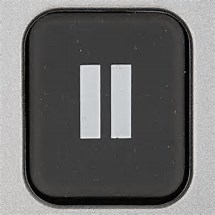
One of the issues I’m hearing about from clients currently is, “I can’t seem to focus” on my work. I understand. I have the same issue!
I’m having a good experience with a technique I offer clients, and one I use myself. It’s called the Pomodoro Technique and it’s a time management method developed by Francesco Cirillo in the late 1980s. Cirillo used a tomato kitchen timer (remember those?) to break down work into intervals, traditionally 25 minutes in length, separated by short breaks.
These intervals are named pomodoros, the plural in English of the Italian word pomodoro (tomato), after the tomato-shaped kitchen timer that Cirillo used.
There are six steps to Cirillo’s original technique:
- Decide on the task to be done.
- Set the pomodoro timer (traditionally to 25 minutes).
- Work on the task.
- Stop work when the timer rings and put a checkmark on a piece of paper.
- If you have less than four checkmarks, take a short break (3–5 minutes), then go to step 2.
- After four pomodoros, take a longer break (15–30 minutes), reset your checkmark count to zero, then go to step 1.
You don’t need a kitchen timer to do this. Just use your smart phone. Find the stopwatch on your phone, start it up and get to work for 25 minutes. If you are distracted before the 25 minutes is up – perhaps you want to check your email or go make a sandwich — the answer is no! You must focus on your task for the full 25 minutes and then you can do whatever you like for your break.
This technique is a way to tame our brains and stay focused. 25 minutes focused, short break, 25 minutes focused, short break. Give it a try.
Happy focusing!

Late last year I scrolled through the offerings at Mabel Dodge Luhan Inn in Taos, New Mexico. I’d been to this magical place before with the incredible Nancy Hill. I attended Nancy’s retreats twice in this setting, and I wanted even more.
Looking at the winter workshops, this one caught my eye: “Rejuvenate Your Creativity in the Magic of Taos!” Yes! I said and signed up. The event promised new ways to access your creative voice and make it a greater part of your life. “If you don’t think you’re creative,” it said, “you’ll have proof that you are. If you’re a writer, you’ll find a new flow…. If you’re an artist, you’ll find out how easy it is to discover words…you’ll discover new freeing techniques.” There would be daily yoga, drawing, painting and writing.
I’ve always been a writer but drawing and painting—ugh—I’ve been blocked about those since 7th grade. I couldn’t do it and I gave up. And yet I registered.
About a week before the class, I emailed Jill Badonsky the instructor and told her I’m dreading the art portion. She wrote back: “You’ve signed up for the right workshop.”
I didn’t buy all of the recommended art supplies because I told myself I wouldn’t be drawing or painting in Taos or anywhere, so why bother. I had high hopes for writing, meeting inspiring women, eating delicious food at Mabel’s, and being creative. I had low expectations and anxiety about drawing and painting.
I can’t explain what happened. I drew and painted with watercolors in that February workshop. I overcame my resistance and somehow did it. It was partly Jill’s cleverness, encouragement and tools; it was somewhat the magic of Taos, and it was in part me, opening myself to this little miracle.
I’ve fallen in love with drawing and watercolor painting. Jill also taught me how to use Snapseed and Waterlogue, two photography Apps. Here’s a little gallery on Pinterest from this beginner artist.
If you’re holding yourself back from something, be gentle with yourself. Take some deep breaths. Open up even just a little bit and give it a try.
For me, this new outlet brings me joy and greater confidence. I’ve registered for a program this summer to sketch Madeline Island’s landscapes, flora and fauna and create a botanical sketchbook. If you’d asked me about this six months ago, I’d say you were mistaken; you can’t be talking about me!
I hope this little revelation of mine inspires you to open yourself up and discover your own miracles.
 How a Life Coach Can Help
How a Life Coach Can Help
Hello Readers! A few months back the editor of this American Bar Association publication, Experience, contacted me. She thought her readers would benefit from an article about life coaching. I wrote this piece, Find Your Focus, to explain what a life coach does, how to find a life coach, example scenarios where a life coach can help, the benefits of life coaching, and more.
The article was published in Experience and I now include it in my blog. I hope you enjoy it!
 One of the messages I return to often in my work is, who do you want to be, right now, in this moment, in spite of FILL IN THE BLANK (too much work, the roof is leaking, the kids are making me nuts, my boss is insane, I’m completely overwhelmed).
One of the messages I return to often in my work is, who do you want to be, right now, in this moment, in spite of FILL IN THE BLANK (too much work, the roof is leaking, the kids are making me nuts, my boss is insane, I’m completely overwhelmed).
Who do you want to be… right now? Even with all that’s going on around you
Just typing this is helping me breathe.
I want to be patient, approachable, calm, and I want to keep my sense of humor! Phew. A tall order but that’s who I want to be. How about you?
As a coach, I hear lots of stories
Life is hard. It’s challenging.Amen to that!And yet when we remember this simple-yet-powerful question, who do I want to be, and how do I want to be, even with –FILL IN THE BLANK — going on, it’s like hitting the pause button on the remote.Stop. Breathe.I have control over this.I can pause the stressful feelings and ask myself:Who do I want to be?Oh, yeah, I want to be peaceful. Ahhhhhh.
When I do this, I feel a shift
I begin to come from a different place.Suddenly the problems and issues don’t seem so bad.I’ve hit the pause button and let my Inner Compass take over.The wise part of me.Now I can approach the challenges in a calm, capable way.
There’s a lot in this world that we cannot control – the weather, what my boss does, how my company decides to restructure itself, whether people like me or not, etc., etc.The list of what we cannot control is super long.
We can try to influence situations and people – and if you have good ideas about influencing, do it!You may succeed. And if we can’t influence, hit that pause button:who do I want to be now that my suggestion was turned down?Oh yeah, I want to be patient, calm and approachable, and perhaps laugh a little.
The one thing you have FULL CONTROL over in this ever-changing life is Who Do You Want to Be?
Hit the PAUSE button and ask yourself that.

When someone asks me what made me decide to become a life coach, I start by saying how I had a wonderful career in association management and I have no regrets on that front. I am a Certified Association Executive (CAE) who had a long, successful career in the association field, most recently as a senior level executive in healthcare. I have experience running a business and I’ve had numerous, varied experiences as an association executive. I had so many amazing opportunities and worked with great people. I also dealt with the ever-growing demands and stresses of today’s workplace. I could have continued on this way for my remaining work years.
Despite the deep satisfaction from my career in association publishing, another type of work has always pulled at me. Years ago, before my association publishing career really took off, I completed a Master of Arts degree in Guidance and Counseling. I loved the coursework and practicum experiences. But because I was enjoying association publishing work, I stayed the course. I noticed that coaching staff members was my favorite thing to do on the job. When I decided to get formal coach training a few years ago, some of my closest friends teased me that I was getting training for something I’ve been doing reflexively for 30 years!
I recognize I am someone who loves to encourage people and help people. I’ve been a mentor to a number of people, formally and informally. Life coaching is in my DNA!
How I prepared to become a full-time coach
So I gave into the pull of those feelings and completed a rigorous coaching training and certification process, which propelled my career in a new direction. I’m now a certified life coach, trained by the very reputable Coaches Training Institute (CTI). The 100 hours of face-to-face coach training were remarkably fun and life changing! The next phase to certification involved 100 hours of paid coaching hours, a weekly 90-minute class, supervision by experienced coaches, a written exam and an oral exam where I had to coach master coaches as other master coaches listened, evaluated, and graded me.
This excellent training featuring CTI’s state-of-the-art coaching model, tools and techniques, coupled with my extensive work experience, help me feel very well equipped to coach people. I’m also certified in a powerful 360 assessment tool and can help people understand how they are perceived in the workplace by their colleagues at various levels in the organization, and change by closing any gaps between who they are and who they want to be.
What I do as a coach
Each person and situation is different, of course, and I tailor my approach and tools accordingly. As a coach, I hold a trusting space for clients to talk with me in a confidential setting. I listen; we brainstorm; we explore different perspectives. I work with clients to get them unstuck and moving again. I help quiet down the inner critic voice we all have inside our heads and bring up the volume on the wise part, the inner compass we all possess. I help tap into the client’s inner resources. The benefits my clients experience and have articulated are more confidence, better decision-making, improved communication skills, more satisfying relationships, and overall enhanced leadership presence. My clients tell me they feel more centered, more decisive, happier and more engaged in their jobs–and their lives.
Watching and experiencing people transform is exciting. I love hearing my clients tell me they feel better. They call me and report that they are feeling surer of themselves, and things are going better at work. The boss is happier, the client is happier and all of this good feedback lifts me up. We sometimes work through some not-so-happy feelings to get to the happy place. For example, fear is a very common feeling in coach work so we spend time exploring the fear the client is feeling, understanding it, getting new perspectives on it, and ultimately letting go of it.
People are overwhelmed in today’s hectic workplace and it’s so satisfying to experience the change as people become less stressed and anxious, gain capacity, and return to enjoying their jobs again. My clients become more engaged and what a thrilling outcome that is for them and me!
Rewards – Freedom – Flexibility
This career change has resulted in big shifts in my work life. I get to decide how I will spend my time. I can select the clients I will work with, how and when. I spend most of my time coaching, and less time on administrative work and meetings. My days are varied and I continue learning so much.
And it’s an honor to work with my clients. They teach me so much. I’m proud of them and the effort and courage it takes to work to achieve their goals. Their positive feedback is highly motivating to me.
My new life as a coach is more aligned with my values and who I am. I feel I have the opportunity to make a greater impact now, more than ever before in my career. I’m so glad I finally listened to my calling!
Every new coaching assignment starts with a conversation. So let’s start talking.
